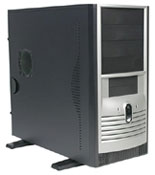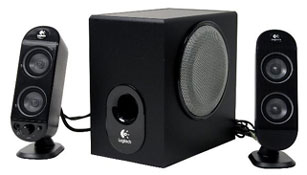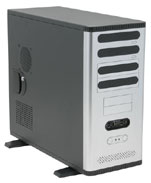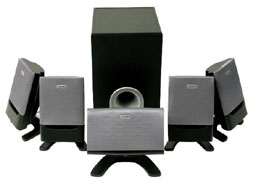Entry Level Buyer's Guide, October 2005
by Jarred Walton on October 14, 2005 12:05 AM EST- Posted in
- Guides
Miscellaneous Part Recommendations
We've covered the major components for a computer, and we'll finish by covering the storage, keyboard, mouse, sound, networking, case, and power supply choices. (That's a lot of choices left, but the impact on performance for most of them is negligible at best.) If you grab the cheapest parts for several of these options - input devices and speakers - then you can get the bare minimum of functionality. Depending on how much you plan on using the computer, though, we'd upgrade some options.
First, the keyboard and mice are how you actually communicate with the computer (unless you're planning on trying out some voice recognition software). If you're going to be using the computer for work, sitting at it eight hours a day, then do your body a favor and get a keyboard and mouse that are comfortable for long-term use. Ergonomic keyboards might help a bit if you have carpal tunnel problems or suffer from RSI (Repetitive Stress Injury). Of course, the truth is that the best way to combat such problems lies elsewhere: a good desk and chair combined with frequent breaks is critical for long-term comfort. The desk and chair can easily cost more than an entire computer; thankfully, upgrades are rare occurrences. We've given you a bit of advice on what you might want to consider, but the rest is up to you. As usual, we're going to recommend a standard keyboard/mouse combo from either Logitech or Microsoft.
Sound and networking devices are really easy to cover: use the integrated devices on the motherboard. Every modern motherboard includes both sound and network functionality. Is it the best sound that you'll ever hear from a PC? Hardly, but you probably won't care much. Networking performance is even less critical; unless you're planning on running gigabit Ethernet wiring, nearly all 10/100 network devices are close enough in performance that discussing it further amounts to splitting hairs.
For the speakers, at least for non-gaming use, just grab a $10 to $20 set (or use what you already have). If you need a truly cheap recommendation, you can get a pair of Logitech S-100 speakers for free with the purchase of a keyboard, courtesy of Newegg. It's tough to beat free (though we're really only saving $7). The sound quality just about matches the price, so if you want something where you could actually listen to a CD or even watch a DVD on your computer, you'll want to bite the bullet and at least get some speakers with a subwoofer. Small satellites simply can't produce bass well, and cheap satellites are even worse. Logitech's X-230 speakers run $37 shipped and provide a good minimum level of sound quality. We'll use those for the home/office setup, but for gaming, we'll upgrade to 5.1 speakers.
Office Components:
Gaming Components:
Most of the choices should be pretty self-explanatory, so we just want to touch on the important areas. First, our hard drive and optical drive selections are essentially a toss up. Our last Hard Drive Roundup showed that SATA 3.0Gbps drives were faster in some areas, and NCQ could help out in certain tests as well, but there was no clear victor. This is a budget guide, so price as well as $/GB are going to be the primary factors in what we select. Hitachi won out in both the 80GB and 160GB categories - we chose a larger drive for the gaming system, though in truth, you could put either drive in either configuration, depending on how you plan to use the PC. The less than 40 cents per GB cost of some Maxtor 250GB models also bears mention, but we aren't big fans of the MaxLine II models and wanted to keep the HDD cost under $100, so we didn't upgrade to a 200GB or larger drive. The 160GB choice will still provide plenty of room for games, videos, music, photos, and whatever else you might want. Combined with the ability to archive old data to DVDR discs, storage capacity shouldn't be a major concern.
The 5-year Seagate warranty (you can get a similar warranty on the more expensive Western Digital drives) is also something to consider, but warranties don't cover lost data. (You might want to wait for the new Seagate drives as well, if you're looking to get a Seagate anyway.) That's why a good backup strategy is important, and the DVDR drives provide that. Firmware updates to the NEC 3540A, BenQ DW1640, and Pioneer 110D drives have ironed out most of the media compatibility issues, so they pretty much tie for price, performance, and compatibility. NEC wins on total cost plus shipping right now, but prices can fluctuate daily, so feel free to choose one of the other models.
The case and power supply choices are certain to draw plenty of comments, as they did with the last budget guide. We actually picked up the MGE CAG-M1-BK with the 400W PSU that we listed to run it through some tests. The quick summary is that the case is flimsy and cheap, the front panel connectors feature individual connections for the USB and Firewire ports rather than a nice molded block, and as a whole, the case is underwhelming. For $65 shipped, though, it gets the job done. It's been running almost 24/7 for a couple of months without any problems, even when overclocking a Sempron to 2.60 GHz. Will the power supply fail at some point? Probably. With the overclocked Sempron and an X800 Pro, though, peak power draw is only hitting 190W or so. For a budget system, you really don't need to go out and buy a $75 PSU in order to run stable. Something else to consider is that since shipping costs about $15 for many cases when ordered online, you might just run down to your local computer shops to see what's available.
The Foxconn cases and power supplies that we chose for this month's gaming selections are of higher quality than the MGE, but they're still not high-end. The "office" selection is a bit cheaper and only includes a 300W PSU (which should be fine for the integrated graphics and other components). For the gaming case, the PSU has a 24-pin power connector (really, this time!), and it's also ATX2.0 compliant. Both have a relatively conservative look, and we like the more expensive model a bit more. It has spring-loaded optical drive doors on the top two 5.25" bays. The cases also include a 120mm fan mounted at the back and a CPU duct, which should easily handle our budget builds.
You may eventually need to upgrade the case a bit with a new PSU or a second fan, but with Intel's talk of performance per Watt, the next generation PCs may actually reduce power requirements. (Here's hoping...) We don't expect people to have problems with either of these cases, but if you start thinking about adding multiple hard drives, you might need a heftier PSU.
We've covered the major components for a computer, and we'll finish by covering the storage, keyboard, mouse, sound, networking, case, and power supply choices. (That's a lot of choices left, but the impact on performance for most of them is negligible at best.) If you grab the cheapest parts for several of these options - input devices and speakers - then you can get the bare minimum of functionality. Depending on how much you plan on using the computer, though, we'd upgrade some options.
First, the keyboard and mice are how you actually communicate with the computer (unless you're planning on trying out some voice recognition software). If you're going to be using the computer for work, sitting at it eight hours a day, then do your body a favor and get a keyboard and mouse that are comfortable for long-term use. Ergonomic keyboards might help a bit if you have carpal tunnel problems or suffer from RSI (Repetitive Stress Injury). Of course, the truth is that the best way to combat such problems lies elsewhere: a good desk and chair combined with frequent breaks is critical for long-term comfort. The desk and chair can easily cost more than an entire computer; thankfully, upgrades are rare occurrences. We've given you a bit of advice on what you might want to consider, but the rest is up to you. As usual, we're going to recommend a standard keyboard/mouse combo from either Logitech or Microsoft.
Sound and networking devices are really easy to cover: use the integrated devices on the motherboard. Every modern motherboard includes both sound and network functionality. Is it the best sound that you'll ever hear from a PC? Hardly, but you probably won't care much. Networking performance is even less critical; unless you're planning on running gigabit Ethernet wiring, nearly all 10/100 network devices are close enough in performance that discussing it further amounts to splitting hairs.
For the speakers, at least for non-gaming use, just grab a $10 to $20 set (or use what you already have). If you need a truly cheap recommendation, you can get a pair of Logitech S-100 speakers for free with the purchase of a keyboard, courtesy of Newegg. It's tough to beat free (though we're really only saving $7). The sound quality just about matches the price, so if you want something where you could actually listen to a CD or even watch a DVD on your computer, you'll want to bite the bullet and at least get some speakers with a subwoofer. Small satellites simply can't produce bass well, and cheap satellites are even worse. Logitech's X-230 speakers run $37 shipped and provide a good minimum level of sound quality. We'll use those for the home/office setup, but for gaming, we'll upgrade to 5.1 speakers.
Office Components:
 |
 |
| Click images to enlarge. | |
| Hard Drive: | Hitachi 3.0Gbps 80GB 7200RPM 8MB Deskstar 7K80 | $57 |
| Optical Drive: | NEC 3540A Black (OEM) | $41 |
| Case and Power Supply: | Foxconn 3GTH-002 plus 300W PSU | $70 |
| Speakers: | Logitech X-230 2.1 Speakers | $37 |
| Keyboard and Mouse: | Logitech Internet Pro Desktop | $23 |
Gaming Components:
 |
 |
| Click images to enlarge. | |
| Hard Drive: | Hitachi 3.0Gbps 160GB 7200RPM 8MB Deskstar T7K250 | $81 |
| Optical Drive: | BenQ DW1640 Black (OEM) | $46 |
| Case and Power Supply: | Foxconn TPS544-S350 plus 350W PSU | $82 |
| Speakers: | Labtec ARENA 685 5.1 Speakers | $47 |
| Keyboard and Mouse: | Logitech Internet Pro Desktop | $23 |
Most of the choices should be pretty self-explanatory, so we just want to touch on the important areas. First, our hard drive and optical drive selections are essentially a toss up. Our last Hard Drive Roundup showed that SATA 3.0Gbps drives were faster in some areas, and NCQ could help out in certain tests as well, but there was no clear victor. This is a budget guide, so price as well as $/GB are going to be the primary factors in what we select. Hitachi won out in both the 80GB and 160GB categories - we chose a larger drive for the gaming system, though in truth, you could put either drive in either configuration, depending on how you plan to use the PC. The less than 40 cents per GB cost of some Maxtor 250GB models also bears mention, but we aren't big fans of the MaxLine II models and wanted to keep the HDD cost under $100, so we didn't upgrade to a 200GB or larger drive. The 160GB choice will still provide plenty of room for games, videos, music, photos, and whatever else you might want. Combined with the ability to archive old data to DVDR discs, storage capacity shouldn't be a major concern.
The 5-year Seagate warranty (you can get a similar warranty on the more expensive Western Digital drives) is also something to consider, but warranties don't cover lost data. (You might want to wait for the new Seagate drives as well, if you're looking to get a Seagate anyway.) That's why a good backup strategy is important, and the DVDR drives provide that. Firmware updates to the NEC 3540A, BenQ DW1640, and Pioneer 110D drives have ironed out most of the media compatibility issues, so they pretty much tie for price, performance, and compatibility. NEC wins on total cost plus shipping right now, but prices can fluctuate daily, so feel free to choose one of the other models.
The case and power supply choices are certain to draw plenty of comments, as they did with the last budget guide. We actually picked up the MGE CAG-M1-BK with the 400W PSU that we listed to run it through some tests. The quick summary is that the case is flimsy and cheap, the front panel connectors feature individual connections for the USB and Firewire ports rather than a nice molded block, and as a whole, the case is underwhelming. For $65 shipped, though, it gets the job done. It's been running almost 24/7 for a couple of months without any problems, even when overclocking a Sempron to 2.60 GHz. Will the power supply fail at some point? Probably. With the overclocked Sempron and an X800 Pro, though, peak power draw is only hitting 190W or so. For a budget system, you really don't need to go out and buy a $75 PSU in order to run stable. Something else to consider is that since shipping costs about $15 for many cases when ordered online, you might just run down to your local computer shops to see what's available.
The Foxconn cases and power supplies that we chose for this month's gaming selections are of higher quality than the MGE, but they're still not high-end. The "office" selection is a bit cheaper and only includes a 300W PSU (which should be fine for the integrated graphics and other components). For the gaming case, the PSU has a 24-pin power connector (really, this time!), and it's also ATX2.0 compliant. Both have a relatively conservative look, and we like the more expensive model a bit more. It has spring-loaded optical drive doors on the top two 5.25" bays. The cases also include a 120mm fan mounted at the back and a CPU duct, which should easily handle our budget builds.
You may eventually need to upgrade the case a bit with a new PSU or a second fan, but with Intel's talk of performance per Watt, the next generation PCs may actually reduce power requirements. (Here's hoping...) We don't expect people to have problems with either of these cases, but if you start thinking about adding multiple hard drives, you might need a heftier PSU.










35 Comments
View All Comments
i am getting angry - Friday, October 14, 2005 - link
As most of you known, I'm usually a big fan of Anandtech, however this time I couldn't disagree more!A "cheap/no name/ POS" PSU is an open inventation to every problem possible!
Very good PSU's can be had for under $30!
Cheap, but Good PSU's! [url]http://www.hardforum.com/showpost.php?p=1027898523...[/url]
I am "davidhammock200" however I couldn't login as me!
JarredWalton - Friday, October 14, 2005 - link
"A 'cheap/no name/POS' PSU is an open inventation to every problem possible!"It depends a lot on how high-end you go with parts. I've got a system sitting two feet from me with that MGE case and PSU. It's running at 2.70 GHz with a Sempron 3100+, and it's been running that way for three months. Did I get lucky? Maybe. More likely, people are just a little too concerned about power supplies and budget systems. $30 more would be enough to upgrade the 19" CRT to a 17" LCD - which do you think most people will choose?
I personally have never encountered instability that I would attribute to a PSU. I've had PSUs fail on numerous occasions, but in every case all it required was a new PSU. I've heard the stories of PSUs taking out the entire computer, and it's certainly possible in theory. I've never actually seen it happen, though.
Maybe I just care for my PCs too well? I do try to give them a good dusting every 3 months, which does wonders for fan life. I also don't try putting high-end builds with low end power. Low end parts with a low end PSU is exactly what you get from Dell and the likes, though. I've got a P4 2.8C Dell at my corporate job that has a 150W PSU. Amazing, eh? And it's been running 24/7 for over two years.
bldckstark - Friday, October 14, 2005 - link
If you want to get PO's about an article take a look at this one that is posted on THG. This is the most ridiculous thing I have ever read. They put together a MAJOR POS, don't use any logic, then also don't have any benchmarks to show what a piece it is. Take a look @ http://www.tomshardware.com/howto/20051014/index.h...">$500 gaming rig from THGYou may disagree with some of the picks here, but that whole system is crap. But at least they stayed in budget! I used to love THG, but now it is ridiculous. They have become a system buyer site, instead of a system builder site. It's like PCWorld bought them or something.
If you were going to build a system for $750, and you found you could build a significantly better one for $100 more wouldn't you do it? Hell, that is only 13%. I recently did the exact same thing. I got an SLI board cuz it was only $20 more. I got a 3200+ on a deal cuz it was only $15 more than the 3000+ on a package deal. I got a 6600GT even though they cost more than I originally thought. I got 512MB OCZ Platinum Rev2 ram cuz I can buy more later instead of 1GB of value ram now. I got a 300GB SATA drive cuz it was cheaper per GB than a 250, but it cost more too. Any project of any kind should have built in 10% contingency plan. In my lonely opinion Jarred is only liable for grief on the 3% over that. So here it is WAAaa.......... (3% of a whine).
bgladwyn - Friday, October 14, 2005 - link
It seems odd to include a speaker package with a subwoofer for an office setup when headphones would do. Similarly, flat panels are useful in the office because of the desk space they liberate. Lose the $37 speakers and shell out $199 for the cheapest 17" TFT on PriceGrabber and you have $33 well spent.JarredWalton - Friday, October 14, 2005 - link
When I say office in this guide, I mean "home office" as opposed to an actual workplace computer. For a workplace, speakers are generally frowned upon. There are many ways to get to an LCD, but quality is a bit more important than price if you're going that route. I'd forget about 15" LCDs and put 17" as the minimum, with a DVI input being preferred. Still, $200 for a 17" LCD isn't bad. $250 will even get you a 19" model, possibly with DVI.Like I said in the displays section, the only reason I didn't include an LCD was to get closer to the $500 price. I highly recommend anyone that can should spend more money on the display, with 19" LCDs being the ultimate goal.
bgladwyn - Friday, October 14, 2005 - link
Fair play, I've read all the article now(!) and can see that you'd already considered this point.ceefka - Friday, October 14, 2005 - link
Any expectations on integrated DVI graphics?I think that a 17" VGA LCD like the Samsung 710v (think it was 12 or 16ms) is quite OK for office use. Granted it is more expensive than a "comparable" CRT. It uses less juice, produces less heat and occupies less space, plus you actually work on that screen. My latest experience on a CRT was that after some time the numbers danced before my very eyes :D Just weigh that in and draw your own conclusions.
pcmatt1024 - Saturday, October 15, 2005 - link
i believe the new 6150 from nvidia (basically the higher end version of what was used on the amd office board) will have dvi out. boards should be out in the next few weeks.
JarredWalton - Saturday, October 15, 2005 - link
I can say for sure that the ATI Xpress 200 and Intel 915G both *can* support DVI output. The problem is that no motherboard manufacturers actually have such support so far. (I know that it's possible because I have two SFF cases with those chipsets, and they both have DVI ports.) Basically, DVI is a "high-end" option and IGP is often "value-oriented". It's sort of like the problem with uATX motherboards: no one makes an "enthusiast uATX" design; they're all built for value. And yes, there are some people that would like a high quality uATX mobo.PrinceGaz - Friday, October 14, 2005 - link
LCD panels are certainly getting better and I know for a fact that my next display (when this Mitsubishi DP 2070SB fails, which hopefully won't be for several years) won't be a CRT as there is already nothing available as good as it.If you were having problems using a CRT, then the refresh-rate was almost certainly too low. Windows 2000/XP defaults to 60hz which is unusable for most people for extended periods with a CRT monitor, and that is probably what you were using. Any half-decent CRT monitor will support at least 85hz at the ideal resolution, with which most people have no problems. Really good CRT monitors will support 100hz or more at their optimum resolutions, but unfortunately those really good CRT monitors can only be bought second-hand now as all the best manufacturers have switched to LCD panels.